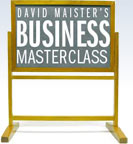

TITLE | TIME |
Ready, Set, Go: Fast-track Strategy | (14:43) |
How can companies get started on operating strategically with a minimum of bureaucracy and planning? How to focus on the four key improvement areas of all sensible strategic plans.
NOTES FOR THE EPISODE:
Timeline:
00:29 —
Here’s how it’s done. You divide the company into small teams or business groupings (by location, by discipline, by industry). Go for the smallest sub-groupings you’ve got, keeping the teams as small as possible. You give each team four sheets of paper which have four key objectives, one to a page.
00:50 —
The four key objectives are to:
- Raise client (or customer) satisfaction
- Increase skill-building and dissemination of skills
- Improve productivity (not just production)
- Get better business
01:10 —
Beneath the objective listed on each page are five columns:
- What actions are proposed
- Which individual will take responsibility for each action
- How much time will be spent on each action
- When each will be done by
- How we’ll know each action’s been done
01:45 —
You tell each group that a “Coach” (either a senior officer or a member of the executive committee) will meet with them for two to three hours in four to six weeks time to discuss what actions they are prepared to commit to do over the next three months to make progress toward the four objectives.
02:15 —
They are informed that only ACTIONS will be accepted, not goals
02:48 —
Each action, it will be noted, must be the responsibility of a specific person: this is not meant to discourage teamwork (different actions may be part of an integrated plan), but is required to ensure a specific focus of responsibility. Many people may be involved in putting on a seminar: but some specific someone must be “on the hook” for ensuring that it all comes together and takes place.
03:18 —
During the discussion of the action plan, the Coach will “test” the feasibility of the plan. Will the proposed actions really make a difference? Has enough time been budgeted to complete each action properly? Is there enough non-billable time available to do it all? Is the team leaning too much on a few individuals? Are there other people who have some time who could be brought into the effort?
04:23 —
The Coach will try to guide the team (gently) to actions that are likely to have a payoff, to work. What the Coach wants is what the team wants — the early successes that breed not only optimism and enthusiasm, but also the morale and commitment to do more — to try it again.
04:41 —
At the end of this conversation, the surviving plan becomes a “contract” between the Coach and the team. Before the meeting concludes, a specific, iron-clad meeting date is chosen approximately three months hence to review the execution of the plan, and its impact — what worked, what didn’t, what proved easy to pull off, what is more complicated than it first looked. At that meeting, in addition to the look-back review, a new action plan covering the next three months (using the same planning forms) will be discussed and agreed to. And so on, and so on, until the process becomes a routine part of the management control systems of the company.
That’s it — that’s fast-track strategy making.
05:55 —
What’s different about this approach to strategy is that it doesn’t waste a lot of time talking about the objectives of the business. The objectives of the business are the same as the company’s — the same as every company’s. If you’re making progress on client (or customer) satisfaction, skill-building, productivity and getting better business — you’ve got all the strategy you need. And if these aren’t your objectives — well, it’s hard to imagine what you are up to.
10:40 —
This brings us to the next virtue of this approach to strategy: Each group is given the freedom and autonomy to plan its own activities — the plan is theirs. They are not being asked to execute the ideas of others (with which they may or may not agree). The group is being asked to plan as a team: together they must develop the action lists to be discussed with the Coach. Planning together and making their own decisions increases the likelihood of enthusiasm in implementation.
11:34 —
The Role of the Coaches
Coaches (usually company management) get to play a key role in this approach to strategy — not by telling people what to do, but by encouraging them to take responsibility for their business’s success (and the company’s success). They must make the process work by giving as much attention and seriousness to reviewing the action plans as they do to the monthly financials. If they do not, the system will wither away as yet another bureaucratic exercise.
12:35 —
The Coaches have a final, perhaps most important role in making the system work. They have the responsibility and the duty to cross-fertilize (“Group X has tried this: do you think it can work for you?”) and to find new linkages (“You guys seem to be thinking along the same lines as one of our other teams — why don’t you talk to them and develop some joint activities?”). By capturing and sharing the best ideas from each team, they can, over time, develop the company’s accumulated experience on “what works”. By encouraging and supporting continued experimentation in each of the four key areas, they will help to breed a flexible, adaptable, responsive organization — one that is constantly trying new things and responding to the marketplace.

















